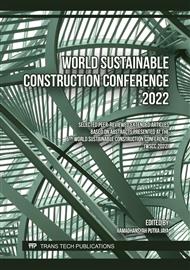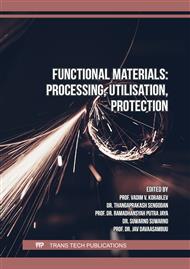[1]
M.S. Bidabadi, M. Akbari and O. Panahi, Optimum mix design of recycled concrete based on the fresh and hardened properties of concrete, Journal of Building Engineering, 32 (2020) 1101483.
DOI: 10.1016/j.jobe.2020.101483
Google Scholar
[2]
S.A. Zareei, F. Ameri, F. Dorostkar, S. Shiran, Partial replacement of limestone and silica powder as a substitution of cement in lightweight aggregate concrete, Civil Engineering Journal, 3(9):727 (2017).
DOI: 10.21859/cej-03099
Google Scholar
[3]
D. Cree and P. Pliya, Effect of elevated temperature on eggshell, eggshell powder and eggshell powder mortars for masonry applications, Journal of Building Engineering, Volume 26, November 2019, 100852.
DOI: 10.1016/j.jobe.2019.100852
Google Scholar
[4]
M. Garside, Global cement production, Statista. (2020).
Google Scholar
[5]
O. Miwil, Builders must continue to improve, New Straits Times. (2018).
Google Scholar
[6]
J. Muller, Production of cement in Malaysia, Statista. (2022).
Google Scholar
[7]
R.A. Al-Safy, Experimental investigation on properties of cement mortar incorporating eggshell powder, Journal of Engineering and Development, Vol. 19, No. 06, (2015).
Google Scholar
[8]
Y. Liu, C. Shi, Z. Zhang, N. Li, D. Shi, Mechanical and fracture properties of ultra-high performance geopolymer concrete: Effects of steel fiber and silica fume, Volume 112, September 2020, 103665 (2020)
DOI: 10.1016/j.cemconcomp.2020.103665
Google Scholar
[9]
O.M. Ofuyatan, A.G. Adeniyi, D. Ljie, J.O. Ighalo, J. Oluwafemi, Development of high-performance self compacting concrete using eggshell powder and blast furnace slag as partial cement replacement, Construction and Building Materials, 256 (2020) 119403.
DOI: 10.1016/j.conbuildmat.2020.119403
Google Scholar
[10]
M.B. Ali, R. Saidur, M.S. Hossain, A review on emission analysis in cement industries, Renewable and Sustainable Energy Reviews, 15 (2011) 2252-2261.
DOI: 10.1016/j.rser.2011.02.014
Google Scholar
[11]
Y.C. Díaz, S.S. Berriel, U. Heierli, A.R. Favier, I.R. Sánchez Machado, K.L. Scrivener, J.F.M. Hernández, G. Habert, Limestone calcined clay cement as a low-carbon solution to meet expanding cement demand in emerging economies. Development Engineering, Volume 2, Page 82-91 (2017).
DOI: 10.1016/j.deveng.2017.06.001
Google Scholar
[12]
C. Harvey, Cement producers are developing a plan to reduce CO2 emissions, Scientific American.
Google Scholar
[13]
M. Waheed, M. Yousaf, A. Shehzad, M. Inam-Ur-Raheem, M.K.I. Khan, M.R. Khan, N. Ahmad, Abdullah, R.M. Aadil, Channelling eggshell waste to valuable and utilizable products: A comprehensive review, Trends in Food Science and Technology, Volume 106 (2020) Pages 78-90.
DOI: 10.1016/j.tifs.2020.10.009
Google Scholar
[14]
P. Kamkum, N. Atiwongsangthong, R. Muanghlua, N Vittayakorn, Application of chicken eggshell waste as a starting material for synthesizing calcium niobate (Ca4Nb2O9) powder, Ceramics International, Volume 41, Supplement 1, July 2015, Pages S69-S75.
DOI: 10.1016/j.ceramint.2015.03.189
Google Scholar
[15]
N.A. Gabol, F.A. Memon, M. Jawaduddin, Z.H. Zardari, Analysis of eggshell powder as a partial replacing material in concrete, International Journal of Modern Research in Engineering & Management (IJMREM), Volume 2, Issue 9, Pages 22-31 (2019).
Google Scholar
[16]
P. Shekawat, G. Sharma, R.M. Singh, Strength behavior of alkaline activated eggshell powder and flyash geopolymer cured at ambient temperature, Construction and Building Materials, 223 (2019) 1112-1122.
DOI: 10.1016/j.conbuildmat.2019.07.325
Google Scholar
[17]
M.E. Mohamad, A.A. Mahmood, A.Y.Y. Min, N.H.A. Khalid, A review of the mechanical properties of concrete containing biofillers, IOP Conf. Series: Materials Science and Engineering, 160 (2016) 012064.
DOI: 10.1088/1757-899x/160/1/012064
Google Scholar
[18]
Y.Y. Tan, S.I. Doh, S.C. Chin, Eggshell as a partial cement replacement in concrete development, Magazine of Concrete Research, Paper 1700003 (2017).
DOI: 10.1680/jmacr.17.00003
Google Scholar
[19]
S Vivek and M. Sophia, Efficient management of egg shell and conch shell wastes by utilization as bio-fillers in eco-friendly gypsum mortar, International Journal of Engineering and Advanced Technology (IJEAT), Volume 9, Issue 2 (2019).
DOI: 10.35940/ijeat.b2509.129219
Google Scholar
[20]
T. Nochaiya, W. Wongkeo, A. Chaipanich, Utilization of fly ash with silica fume and properties of Portland cement-fly ash-silica fume concrete, Fuel, 89 768-774 (2010).
DOI: 10.1016/j.fuel.2009.10.003
Google Scholar
[21]
L Black, Low clinker cement as sustainable construction material, Sustainability of Construction Materials (Second Edition), Woodhead Publishing Series in Civil and Structural Engineering, Pages 415-457 (2016).
DOI: 10.1016/b978-0-08-100370-1.00017-2
Google Scholar
[22]
M.A. Moghadam and R.A. Izadifard, Effects of zeolite and silica fume substitution on the microstructure and mechanical properties of mortar at high temperatures. Construction and Building Materials, 253 (2020) 119206.
DOI: 10.1016/j.conbuildmat.2020.119206
Google Scholar
[23]
D. Tavakoli, M. Hashempour, A. Heidari, Use of waste materials in concrete: A review, Science & Technology, 26 (2): 499-522 (2018).
Google Scholar
[24]
B. Sibin and A.N. Rizalman, A. N. Study on the preparation of eggshell powder as a partial cement replacement in mortar, International Journal of Advanced Research in Engineering Innovation, [S.l.], v. 3, n. 1, pp.43-52, mar. 2021.
Google Scholar
[25]
H. Asrah, A.K. Mirasa, M.A. Mannan, The Performance of ultrafine palm oil fuel ash in suppressing the alkali silica reaction in mortar bar, International Journal of Engineering and Applied Sciences (IJEAS), Volume 2, Issue 9 (2015)
Google Scholar
[26]
S. Barbhuiya and M. Qureshi, Effects of silica fume on the strength and durability properties of concrete, 1st International Conference on Civil Engineering for Sustainable Development – Opportunities and Challenges, (2016).
Google Scholar
[27]
S.O. Ehikhuenmen, U.T. Igba, O.O. Balogun, S.O. Oyebisi, The influence of cement fineness on the structural characteristics of normal concrete, IOP Conf. Series: Materials Science and Engineering, 640 (2019) 012043.
DOI: 10.1088/1757-899x/640/1/012043
Google Scholar
[28]
N.T. Lam, Assessment of the compressive strength and strength activity index of cement incorporating ash, IOP Conf. Series: Materials Science and Engineering 869 (2020) 032052.
DOI: 10.1088/1757-899x/869/3/032052
Google Scholar



